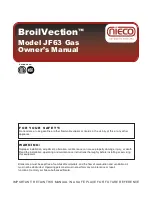
Section 9: Condensate Disposal
Page 33
9.7 Condensate Trap
The boiler of the Grant VortexAir hybrid is supplied with a factory-
fitted condensate trap to provide the required 75 mm water seal in
the condensate discharge pipe from the boiler.
This trap incorporates a float (which will create a seal when the trap
is empty) and an overflow warning outlet (fitted with a plastic sealing
cap), see Figure 9-2.
The trap is factory-fitted inside the boiler casing. It is located behind
a removable panel in the lower front corner on the left side boiler
casing panel. The outlet connection to the trap is directed towards
the rear of the boiler. Refer to Figure 9-3.
The condensate discharge pipe should be run from the trap outlet
and out of the casing through one of the holes provided; either in
the case of the enclosure or next to the access panel of the trap.
Refer to Figure 9-4.
Access must be available to allow for routine maintenance.
NOTE
!
A flexible hose connects the outlet of the condensing heat
exchanger to the trap inlet. Ensure the straight connector on the
hose is fully pushed onto the 'top hat' inlet connector of the trap.
With the trap fitted inside the boiler casing, the sealing cap must be
fitted.
If connecting the condensate discharge (either internally or
externally) into a waste system or soil stack - the sealing cap must
be fitted in the trap outlet.
On external discharge systems to a hopper, gully or soakaway, the
sealing cap should be removed from the trap outlet.
If there is any discharge of condensate from the overflow outlet, this
could indicate a blockage (possibly due to freezing). Turn off the
boiler and investigate the cause. If necessary contact your service
engineer for assistance.
The condensate trap outlet is at an angle of 48° below the horizontal.
This is to automatically give a 3° fall on any 'horizontal' runs of
condensate disposal pipe. Refer to Figure 9-2.
9.8 Condensate Disposal Pipework
The outlet of the trap will accept 21.5 mm to 23 mm OD
Polypropylene overflow pipe for the condensate discharge pipe.
Possible routes for disposal pipework
The boiler enclosure has several 30 mm diameter opening in the left
side panel (next to the trap access panel). There is also a second
opening in the base of the boiler unit. Refer to Figure 9-4. Either of
these openings can be used to allow the condensate disposal pipe
to exit the enclosure in one of the following ways:
Side outlet:
The opening on the left side of the enclosure can allow the
condensate disposal pipe to be installed as follows:
•
Connection to an internal stack – passing back through the wall
of the house.
•
Connection to an external soil stack adjacent to the boiler.
•
Discharge into an adjacent (external) drain or gulley.
•
Discharge into a soakaway – with pipe either above or below
ground level.
Bottom outlet:
The opening in the base that can allow the condensate disposal
pipe to be installed as follows:
•
Discharge into a drain or gulley beneath the boiler (e.g. drain
built in to the concrete base for the boiler).
•
Discharge into a soakaway – with pipe below ground level.
When connecting plastic discharge pipe, ensure that the
pipe is fully pushed into the outlet end on the flexible pipe to
prevent the possibility of leakage.
Ground level
32 mm waste pipe external to the building
Minimum 2.5 fall
O
25 mm
300 mm
400 mm
min.
Two rows of 3 x 12 mm
holes at 25 mm centres
and 50 mm from the bottom
of the tube. Holes facing
away from the property.
Cement seal
100 mm plastic tube
Sealed end
Backfill with 10 mm
limestone chippings
Figure 9-1:
Purpose made condensate soakaway
Содержание Aerona3 Series
Страница 57: ...Section 13 Flue System and Air Supply Page 57 Figure 13 8 Flue clearances...
Страница 77: ...Section 19 Spare Parts Page 77 Figure 19 4 15 21kW baffles Figure 19 5 21 26kW baffles...
Страница 84: ...Appendix A Page 84 Appendix A...
Страница 85: ...Appendix A Page 85...
Страница 86: ...Appendix A Page 86...
Страница 87: ...Appendix A Page 87...
















































